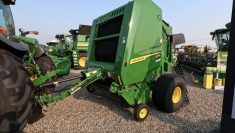Optimum hay storage means optimum feed value for livestock.
Storing hay inside is the best protection, but the amount of hay grown on the Prairies and the cost of storage make that option impractical for many cattle and hay producers.
However, there are proven ways to limit spoilage through bale preparation and stacking.
“Mainly the damage occurs when water penetrates the outside layers of the bale,” said Alberta Agriculture beef and forage specialist Barry Yaremcio.
Further loss occurs when livestock reject weathered or mouldy portions while picking through a bale.
Read Also

Soybean market still figuring out implications of China-U.S. pact
Soybean futures had a muted reaction to the U.S. trade deal with China as the market tries to figure out the nuances of the deal.
“The cows will tend to pick through the stuff that’s been damaged by weather, and the waste factor will go up,” Yaremcio said.
John McGregor of the Manitoba Forage and Grassland Association recommends using net wrap rather than twine because it helps protect bales from rain and snow.
“(Net wrap) keeps the bale more uniform in shape and therefore with the water running off of it, you know there’s not that much soaking into it,” he said.
Yaremcio said stacking bales properly also protects feed value. For example, producers shouldn’t stack round bales in pyramids because it promotes moisture spread through the stack.
“Any place those bales are touching, you’ll see a bunch of damage,” he said.
“Typically the hay turns dark brown or even black in colour because there’s been heat. There’s enough moisture there to cause microbial activity and heat formation, and you get the damage in the hay.”
He said the “mushroom” method is preferable if bales must be stacked. The first bale is laid with the flat end on the ground and a second bale is set on top with the round side up.
“(The mushroom stack) is less damage than what you get with the pyramid pile, but … wherever those bales are touching, that’s where you’re going to get the damage in the water that melts or drains off the top of that top bale (and) goes into the bottom one.”
The best way to store bales outdoors is to set them in individual non-stacked rows with a metre of space between the rows.
Storing on a gentle slope, if available, or on a raised bale pad is also recommended.
McGregor said north-south rows are ideal.
“With the sun moving east to west, if your bales are running north and south it gives all sides of the bale a fairly equal opportunity to get exposure to the sun.”
Bales are best stored on coarse gravel, and sites near trees should be avoided because they promote snow drifting and prolong melting.
Contact ashley.robinson@producer.com















